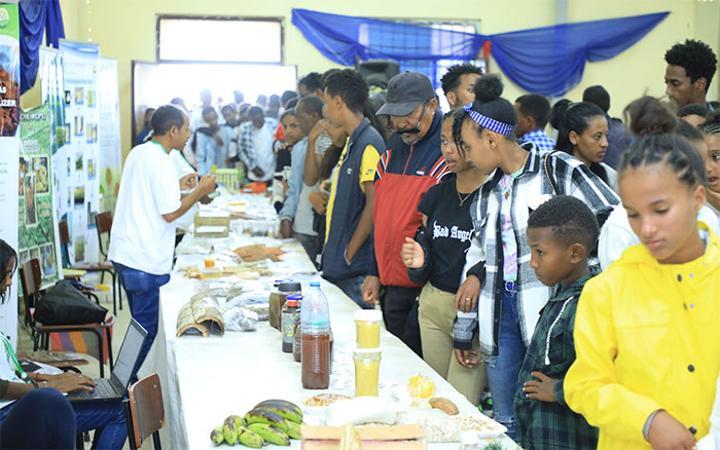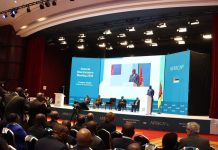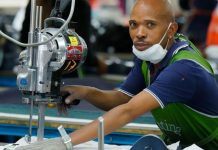Africa-Press – Eritrea. National Eritrean Festival was not held for three consecutive years following the COVID-19 Pandemic. After a long period of discontinuity, this festival was again launched from 13 to 20 August 2023, in Asmara at the Expo ground. The Ministry of Agriculture (MoA), as part of its outreach activities to disseminate information on priority areas during such events held exhibition at the Students’ Recreation and Innovation Center. This Newsletter presents a brief information based on interviews conducted with the representatives of the ministry’s exhibitors.
Coordinator of the Exhibition
My name is Andemeskel Berhe. I work for the MoA’s Public Relations Division, and I was tasked to coordinate the Ministry’s Exhibition in the festival. This exhibition displayed several activities of the MoA bodies; namely, National Agricultural Research Institute (NARI), Agricultural Extension Department (AED), Regulatory Services Department (RSD), National Agricultural Plant and Health Laboratory (NAPHL), Public Relations Division (PRD), and Agricultural Strategic Information Systems Division (ASISD)
Traditional agricultural tools from Eritrean nationalities in highlands and lowlands were staged for the first time, featuring the ongoing efforts of establishing an agricultural museum. In this connection, I would like to share that we received highly motivational feedbacks. Thus, further efforts need to be exerted in this regard, and preparations for the next festival should take note of this.
Among the interesting exhibits were the appealing models presented by the Agricultural Innovations Unit of ASISD. Important comments that could enhance the innovative ideas for better performance of farmers were delivered by most visitors.
The joint initiative of promoting productions of organic fertilizers and pesticides by the MoA and the Ministry of Marine Resources (MoMR) was also represented in the exhibition, while Eritrean Women in Agri-business Association (EWAA) displayed various agricultural products, including that of dairy, mushroom, eggs, spices, honey, sweet potato and packed food items. This was also a corner which won appreciation on the part of the visitors.
***
NARI Representative
My name is Samuel Bereket. I am NARI’s staff, and tasked with coordinating NARI’s exhibition at the festival 2023. NARI was involved in the National Festival by portraying important research
through posters. Out of more than 6000 indigenous and adopted plant species (cereals, legumes, oil crops, fodders and herbs) that have been preserved by the Genetic Resources Division, a total of 83 species were packed and exhibited during the event. Moreover, a range of soil sampling apparatus; around 10 soil types; compost and chemical fertilizers; laboratory equipment; as well as seeds of indigenous trees and shrubs were part of the exhibits.
Furthermore, NARI’s current endeavors of crop genetic improvement were displayed by the research outcomes thereof. For example, sustainability of rapeseed seed as a source of oil was demonstrated and three sweet potato varieties were displayed. Additionally, vines of sweet potato plant were distributed to visitors during the exhibition. Cassava plant, which has recently been introduced in our country, was familiarized; and a number of models of insect species specimen were displayed physically in this year’s National Festival.
Posters reflecting research outcomes on green feed (grasses and legumes); indigenous ovine and caprine species; several feed blocks; and calf starters were put on show. Equally worth mentioning is the demonstration of biotechnological research studies, especially those that are based on tissue culture, and our visitors were provided with briefings concerning the process of reproducing potato, banana and dates. Efforts that are being exerted to widely introduce food technology were represented in the National Festival through value addition outcomes pursuing sweet potato, flux seed, peanut, cassava and pumpkin. Besides fortified complimentary food for children which is known as “DMK” was also presented.
***
AED Representative
I am Efrem Araya, Head of Hide, Skin and Rangeland Unit in the AED. And I was involved as the coordinator of my department’s participation in the National Festival.
Our exhibition presented three types of beehives: Traditional beehive, modern frame beehive and top-bar hive. These were exhibited to demonstrate the differences and merits among these hives, whereas male and female rabbits, and some poultry species were also brought at the exhibition physically with the intent of informing people regarding the ministry’s plan to distribute such animals. Prototype of the energy-saving improved stove, a manual of recipes, as well as a model-based demonstration of the Minimum Integrated Household Agricultural Package (MIHAP), were also shown. Value-added banana and sweet potato products were also included in the exhibited items with a view of demonstrating breads, cakes, juices and other types of foods can be prepared from these products.
We also, staged a model regarding soil and water conservation; and water catchment. We did this to promote soil and water conservation practice among the farming community.
***
RSD Representative
My name is Selam Abraham. I am Food Safety Professional who works for the RSD; and I was tasked with coordinating the activities regarding our department. What we communicated at the exhibition was generally related to raising awareness on RSD’s overall regulatory interventions, including the proclaimed and draft regulatory proclamations, policies and manuals. We also displayed the publications we use to promote public awareness, in addition to short dramas and videos.
Videos outlining our activities, publications on foods safety, and equipment that we use to carry out several regulatory activities were part of the display. Furthermore, to promote public awareness on the precautions of pesticide application, the use of pertinent personal protective equipment was demonstrated.
***
NAPHL Representative
I am Amanuel Tekle, Head of Seed Laoratory Unit at the NAPHL. With regards to the elements of the exhibition that represented NAPHL, they reflected the national laboratory’s long-standing history since 1903 coupled with its role in the eradication of Rinderpest, and the international award Eritrea got from the World Animal Health Organization (OIE).
The vaccines which used to be produces by this laboratory in 1903 were presented along with the two new types of vaccines produced this year; namely, PPR and NCD vaccines. It was explained that the quality of both vaccines have been approved by the African Union Pan African Vaccine Center (AU-PANVAC). We further displayed specimen of plant pests and diseases, and some equipment that are necessary for plant disease diagnosis.
***
ASISD Representative
My name is Almaz Gebreyohannes. I am the Head of Agricultural Innovation Unit at ASISD. The unit generally displayed three demonstrations targeting urban gardening, hydroponics and free energy water pump. We displayed these demonstrations to raise public awareness in general, and urban people in particular. The demonstrations were prepared with the intent to tell visitors they should not worry about space limitation as urban gardening can be practiced either vertically or horizontally using discarded materials, for example, plastic bottles, used car tyres, jerrycans, grain bags etc. People can harvest nutritious foods from their homes and be in a position to meet some of their household consumption needs.
Hydroponic fodder production was alson part of the demonstration to inform the public that both human and animal food can be produced within a very short time without soil. In addition to the fact that it doesn’t demand much space, harvests can be made with less water supply and less human power.
Zero-energy water pump is another technology we have been trying to introduce. It was one of the exhibits which drew the attention of many visitors. Using this gadget, water is pumped from deep underground or wells with air pressure and gravitational force. Anyone who is associated with the practice of farming can use this technology as it helps avoid energy costs.
***
Representative of Post-Harvest Management at AED
My name is Hariena Kibrom, from the AED of the MoA. I work as Post-Harvest Management Expert in the Horticulture Development Unit. Concerning this year’s National Festival, our focus was exhibiting products and methods of production to raise public awareness on value-addition of banana, citrus and sweet potato. We have displayed green raw banana, which is versatile source of different types of food recipes. For example, it can be included in preparing the local dishes Keyh- Tsebhi (hot sauce) and Alcha (stew). It can further be cut, dried and kept as a powder for long-term use. This way, it can be mixed with wheat flour and processed into different types of cakes, bread and biscuits. Oranges are prepared as marmalades including their peel, which has higher nutritional value than raw orange itself. We also managed to demonstrate sweet potato in the forms of juice, cake and biscuits. All such food products were displayed in a bid to positively influence public taste.
***
Representative of Food Technology at NARI
My name is Tsinat Berhane. I work as the Head of Food Technology Unit in NARI. While we strived to represent NARI’s activities as much as possible through the ministry’s exhibition on the festival, we planned to give special focus to cassava, which the Ministry is trying to introduce in a short period of time. Its origin is in South America and is widely consumed in other African countries.
There are two types of cassava-based on taste: Sweet and bitter.
We have exceptionally targeted the sweet cassava and thus we have been conducting trials in Akurdet, Shambko and Halhale. So far, promising results have been registered and its multiplication phase will start very soon. Cassava is highly nutritious especially in terms of carbohydrates. It has double nutritional value compared to that of potato. When preparing cassava, we must cut both edges and boil it in water first, because it has harmful elements which should not be consumed by humans. Following this, it can be cooked using a variety of recipes.
***
Representative of EWAA
My name is Abrhet Habtegergish, Chairperson of the Eritrean Women in Agri-business Association (EWAA). This association was established in 2003. It has now more young members and is growing gradually. All members of this association are engaged in value-addition of agricultural products.
EWAA had a chance to display agricultural products in the National Eritrean Festival 2023 through its members thanks to the Ministry of Agriculture’s support. The products include biscuits, cakes, pumpkin juice, dairy products such as milk, white yogurt, flavored yogurt and butter; mushroom, eggs, spices, herbs, honey products, sweet potato, a range of crop and cereals products like fortified supplementary food for children, cassava, Shiro (popular local spicy pea powder and Berbere (local hot pepper powder) and related products such as Awaze (hot paste), among others.
***
Representative of Food Processors EWAA
My name is Asmeret Damir, a member of EWAA. Our group is predominantly engaged in food processing and packing, especially targeting products made from sweet potato. We use two varieties of sweet potato: The orange and white varieties. We use sweet potato and wheat in equal proportions to prepare biscuits, while we adhere to application of 30% of sweet potato and the 70% of wheat for the preparation of bread. In making a starter food for infants, we depend on sweet potato and other cereals.
Moreover, we have managed to produce fortified supplementary food for children from sweet potato, crops, cereals and oil crops. Red Taff biscuits and banana biscuits were also on the display. Every food product from the association’s members is completely dependent on organic agricultural produces, which are also easy to prepare at home.
For More News And Analysis About Eritrea Follow Africa-Press







